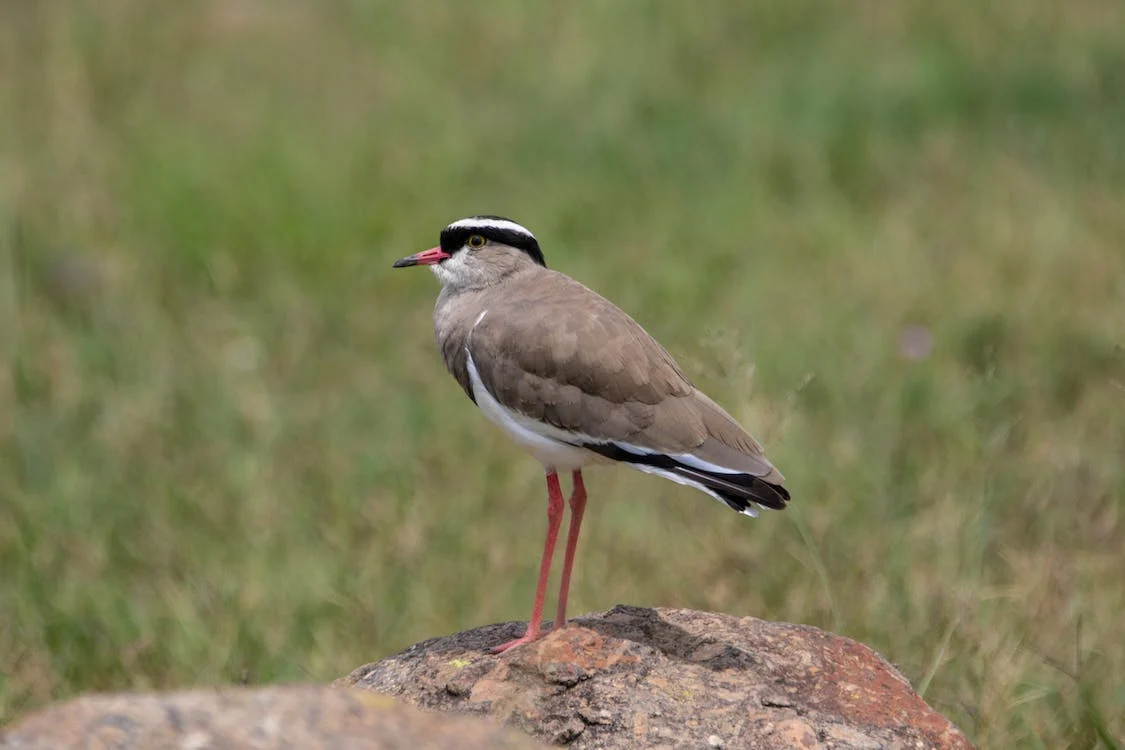It is a huge, vigilant-looking, brownish lapwing, with a conspicuous annular white halo, circled by a black crown. Small groups occur in open dry habitats, such as open grasslands and scrublands, and sparse woodlands. Mostly resident, but may do necessary movements should there be adverse conditions in their habitat. These birds love to forage for termites, ants, and other invertebrates. Their call is characterized by a series of rowdy, scraping “kire” notes.
Read further to know more about the Crowned Lapwing.
What is a Crowned Lapwing?
Crowned Lapwing (Vanellus coronatus), also known as the crowned plover, is a bird species from the family Charadriidae, occurring in much of sub-Saharan Africa. It is an adaptable bird, thriving in dry open habitats. Its cousins are Senegal and Black-winged Lapwings that resemble some of its plumage features.
Its seven levels of classification are as follows:
Kingdom: Animalia
Phylum: Chordata
Class: Aves
Order: Charadriiformes
Family: Charadriidae
Genus: Vanellus
Species: V. coronatus
Crowned Lapwing Physical Description
Crowned Lapwings sport brown upperparts and chest, white belly, and light brown to whitish cheeks. The most striking part of their plumage is their annular white halo, circled by a black crown. Meanwhile, the tail is white with a wide black stripe. Undertail feathers are white. A white diagonal stripe is observed on the wings. Eyes are brownish-orange outside the non-breeding season, turning yellow in the breeding period. Long legs are red. The bill is also red, with brownish to blackish tip. Adults measure around 11.8 to 12.2 inches or 30 to 31 centimeters. Males are slightly larger than females. Juveniles or immature birds have a paler plumage, with yellowish legs, while the bill lacks the reddish tone.
Where can they be spotted?
Crowned Lapwings is spread throughout much of sub-Saharan Africa, occurring in Botswana, Namibia, Zimbabwe, Zambia, Mozambique, and South Africa. They thrive in dry, open habitats, such as sparse woodlands, open scrublands, open grasslands. These birds may also occur in man-made habitats, such as pastures, golf courses, roadsides, and airports. While it is mostly resident, it may perform specific movements within its range due to the changing conditions in its habitat.
Interesting Facts You Should Know About the Crowned Lapwing
Crowned Lapwings feed primarily on insects, with termites composing up to 90% of its diet. Other food items it consumes include ants, beetles, grasshoppers, spiders, earthworms, and millipedes. Like its plover cousins, it performs a “running-stopping” motion, then searches for prey on the ground.
Their range overlaps with the Black-Winged Lapwings, but both species seem to go well and do not display mutual aggression, during or outside the breeding season. They are even seen sharing foraging sites. However, male crowned lapwings may perform aggressive displays once nests are established to declare their nesting territory.
Display flights are also conducted by the male to attract the females towards the defended range. The female will follow the male as a sign of acceptance. They are monogamous and will form life-long bonds with their partners. The nest is placed on a shallow depression on the ground, lined with dried roots, grass, dung, and stones, and hidden among short vegetation.
Egg-laying may happen throughout the year, but peaks from August to December. The female Crowned Lapwing usually lays a clutch of 2-4 eggs, which she will solely incubate. The male may take over once in a while should the weather become too hot.
After hatching, chicks can already leave in a few hours. The parents take intervals in caring for the chicks, teaching them the location of food items. Should there be any predator, the broods will hide while the guarding parent does distraction displays to lure the intruder away. The chicks will fledge after about 29-31 days and become independent in the next breeding period.
Crowned Lapwings’ population is increasing, as they have adapted to the modifications made by humans to various habitats. They are currently classified as Least Concern (LC) under the IUCN Red List of Threatened Species.
WILDLIFE PARKS AND RESERVES WHERE THIS SPECIES IS FOUND:
BOTSWANA
SOUTH AFRICA
Kalahari Gemsbok National Park
NAMIBIA
ZAMBIA
ZIMBABWE
BOTSWANA BIRDS | SOUTH AFRICA BIRDS
NAMIBIA BIRDS | ZAMBIA BIRDS | ZIMBABWE BIRDS
